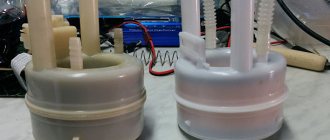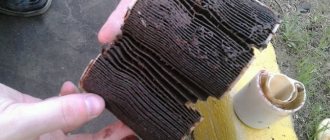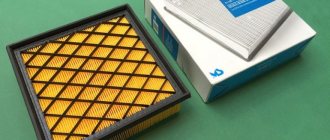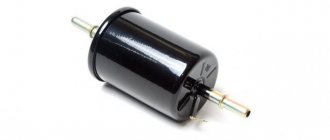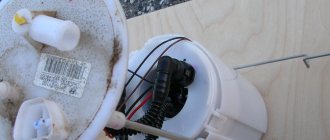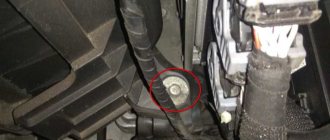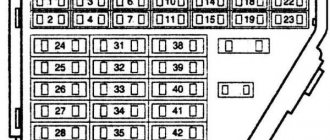Fuel filter
, and in English it sounds like Fuel Filter - this filter element of the fuel system is designed to filter out particles of dust, dirt, debris and rust from the fuel mixture to prevent them from penetrating the fuel supply system.
This avoids the creation of plugs in the fuel pipes, as well as clogging of the injectors. photo gallery:
Types and principle of operation of the fuel purification system
The fuel filter design of a modern car assumes the presence of at least two degrees of purification. At the first stage, rough cleaning is carried out, during which large debris is eliminated. The second stage is fine cleaning with another filter, which is considered the main one. It is impossible to give a definite answer to the question of where the fine fuel filter is located, since its exact location depends on the car model and the type of fuel system implemented in it. But in any case, it is installed between the engine and the fuel tank, while a coarse filter is placed in the tank itself, even before the fuel pump.
Fuel filter device
The type of filter installed in the car depends on the type of fuel supply system, which can be:
- carburetor;
- injection;
- diesel
Fuel filters depending on the type of fuel system.
Don't forget about safety
- Before replacing elements of the fuel system, it is necessary to disconnect the ground on the battery - this will protect against the appearance of an accidental spark and ignition of the fuel.
- It is better to carry out work at moderate temperatures. If you need to replace it in the summer in the heat, you need to avoid direct sunlight.
- Smoking and using open flames while working is strictly prohibited.
You should not be negligent in cleaning the fuel - this will shorten the life of the power unit!
The filter device is not so expensive that you can save on it, and replacing it does not require much skill and knowledge. Therefore, it makes no sense to save on it. Since replacing a piston or overhauling an engine will cost a lot.
Where is the fuel filter located?
When asked where the fuel filter is located
fine cleaning cannot be given a definite answer, since its exact location depends on the car model and the type of fuel system implemented in it.
But in any case, it is installed between the engine and the fuel tank. Often the filter is installed - under the hood
,
under the bottom
or
in the fuel tank
of the car along with a fuel pump and a coarse fuel filter.
In a carburetor system
The filter is installed
in front of the carburetor
. Most often it is made in a transparent housing to facilitate control of clogging. This design allows you to visually determine when changing the fuel filter becomes extremely necessary. Filters for carburetor engines are the simplest, since such engines are not too demanding in terms of the purity of the fuel mixture.
In injection engines
Due to the use of nozzles, high-quality filtration is required to filter out particles with a size of 10 microns.
Considering this, as well as the high pressure in the fuel supply system, the fuel filter itself is most often made of metal, and the filter element requires regular maintenance and cleaning. Such filters are located under the bottom of the car
, which simplifies access to them.
In diesel engines
Fuel purification must be of high quality due to the increased sensitivity of fuel equipment.
Since diesel fuel contains a lot of moisture, filters for such engines differ from gasoline ones because they must condense and remove water from the fuel mixture. Well, the fuel filter is located in diesel engines, also between the fuel pump and the engine
.
It should be noted that due to the paraffin content in diesel fuel, filters are often equipped with heating, since this substance crystallizes in the cold and can quickly clog the filter element.
Regardless of the engine type, manufacturers recommend replacing the fuel filter or filter element (on diesel engines) at least 30,000 km.
Why are they even needed?
Forced fuel cleaning is a necessity to ensure the performance of any engine running on liquid fuel. Filling the filter cavity, gasoline passes through a layer (there may be several of them) of filter material, leaving on its surface particles of dust, dirt and other solid inclusions that adversely affect engine parts.
If the “food” ration of a car engine is diesel fuel, then an additional separator is required that will help clean the fuel, in addition to mechanical inclusions, from water content.
Its operating principle is based on the fact that water is heavier than diesel fuel, and centrifugal force helps separate them from each other. Due to the specific operation of separators, most of them are heated.
What are they, fuel filters?
There are three main groups:
- fuel pre-cleaning filters;
- fine fuel filters;
- fuel separators.
The first group is not very popular for passenger car engines. In them, the removal of large and small particles of impurities from the fuel is entrusted to one filter.
The second group is the most common. Filters of this type can be either case-mounted with threaded fastening, or in the form of filter elements that do not contain metal.
The difference between coarse and fine filters is mainly in the paper. If preliminary cleaning involves retaining particles measuring 75-100 microns, then final cleaning in the best filters allows you to retain particles up to 3-5 microns in size.
Filter elements can be designed with metal covers (for reliable fastening of the filter material) and can be designed with or without reinforcing mesh. Both are always installed in housings made of heat-resistant material.
This design provides for the presence of repair kits, since re-installation of sealing rubber bands and copper washers is not recommended.
It should be noted that the most popular filter material for fuel filters is paper.
Having been born more than a hundred years ago due to a technological error, it is still firmly in the lead among all filter materials.
To extend the service life of the filter, increase the filtration area and thereby improve the quality of the process itself, the paper is installed in the form of corrugations. The density of the folds in it is such that a “curtain” more than one meter long can fit in an “accordion” with a diameter of 100 mm.
By the way, in the cost of a fuel filter, the cost of filter paper is more than 60%, which means that the manufacturer can reduce its price only by losing quality!
Recently, filter materials based on propylene have been increasingly used and have already earned the approval of motorists. A small sector among filter elements is occupied by those made of fine-pored metal mesh.
The classic shape of fuel filters is the cylinder. Replacement cartridges for separators can be rectangular in shape in a metal or plastic case.
Replacing the fuel filter
Carburetor cars are quite old, and there are no difficulties in replacing the filter, since you just need to remove two tubes and change the element, so it’s not worth dwelling on this in detail, but you can consider replacing the fuel filter of injection cars and diesel cars so that their owners do not made hasty mistakes.
To replace the fuel filter on a gasoline or diesel car, you will need a standard set of tools: a wrench or socket wrenches, a screwdriver, pliers, etc.
Replacing the fuel filter gasoline
On injection cars, the filters of which are located under the car, in the area of the fuel tank, will be the easiest to change, because there you need:
- unscrew the clamp
- remove the fuel pipes on the sides (they can be either on clamps, removed with pliers, or plastic quick releases, you need to press down on the sides).
On gasoline cars with a filter installed in the tank (the so-called fuel station), the procedure is a little more complicated, since you will need to:
- remove the back seat
- open the hatch,
- unscrew the fixing nut,
- remove the hoses,
- fuel pump power connector,
- disassemble the fuel station housing in order to separate the fuel filter itself.
Replacing the fuel filter on a diesel engine
Diesel engines are not only the most powerful, but also the most demanding in terms of fuel quality. Due to the fact that diesel fuel has many different impurities and moisture. The filter of such cars differs from the filters of gasoline cars, like an injector or carburetor, so replacing the fuel filter of a diesel car is also significantly different.
To replace a diesel engine fuel filter, you may additionally need a manual booster pump (bulb) and a container for draining/pumping out fuel. Same as in the previous version:
- all fasteners are unscrewed
- the fuel hoses are disconnected from the filter cartridge,
- you need to remove the water sensor connector (if equipped)
- and change the filter.
But if the housing has a removable filter element, then the task becomes more complicated, and you will also need to remove water and dirt. After replacement, on many cars with a diesel engine, in order for the filter to fill with fuel, you need to use an additional booster pump to avoid airing the fuel system. All details of the procedure must be looked at in the repair manual for a particular car!
When to change the fuel filter?
Often, according to many drivers, the fuel filter service life is from 30 thousand km
mileage on diesel cars, up to
60-100 thousand km
running on gasoline.
Automakers often claim that the service life of the fuel filter on their car is equal to the life of the car. However, such statements are not at all realistic for our operating conditions and fuel quality. The fuel filter cannot provide good flow for such a long time. So, each driver decides for himself how often to change the fuel filter and what quality to use.
Untimely replacement of the fuel filter not only threatens the failure of the fuel equipment, but also leads to serious problems for the fuel pump, since it forces it to work under increased pressure, as well as increased wear on the units responsible for starting the engine. Therefore, in such cases, car owners change the fuel filter as soon as the first signs of clogging appear.
In particularly advanced cases, a dirty fuel filter may look like this.
Causes of typical malfunctions
Many car manufacturers seriously claim that a modern fuel cell can last the entire service life of the car. However, in reality, such a result is simply impossible to achieve. If filters can work for such a long time, then only in a sterile laboratory. The quality of fuel supplied to gas stations in our country is, frankly speaking, low. There may also be various debris found there, which does not have the best effect on the fuel system. So, garbage and dirt are the cause of all problems with the car.
Signs of a faulty fuel filter
The following signs indicate that the filter is clogged:
- uneven engine operation;
- a noticeable drop in engine power in the absence of other problems with it;
- increased fuel consumption.
In the fuel system of an injection car, the coarse fuel filter (in the gas tank) is the first to suffer from low-quality fuel.
As a rule, a blockage problem manifests itself gradually, and the symptoms immediately seem very minor, increasing over time.
Fuel filter error
One of the signs of a problem with the filter may be a decrease in pressure in the fuel rail, this will be reported by the check engine light on the panel and error code P0087, which can be quickly read using the Scan Tool Pro Black Edition
. You just need to insert it into the ECU diagnostic connector and connect from your phone via any available application via Wi-Fi or Bluetooth.
Of the 4 main causes of fuel pressure errors, a clogged fine or coarse fuel filter (fuel pump mesh) is precisely the main problem from which the fuel pump itself and the entire fuel system suffer. The scanner’s ability to not only read errors, but also look at the performance indicators of the sensors responsible for fuel supply and dosing will help more accurately determine the cause.
Deciphering diagnostic code p0087
Notification on the dashboard of a diesel car about the need to replace the fuel filter
Some cars also have a sensor that is responsible for indicating the need to replace the fuel filter, but it can send such a signal to the panel not only when there is a clog or a large amount of water in the filter (in diesel cars), but also when the fuel is simply bad. Scan Tool Pro scanner
, which has a 32-bit chip, and not 8-bits like its analogues, this fact can be checked and in case of a false positive, the error can be reset. This device will also allow you to check both the engine and other components and assemblies of the car (gearbox, transmission, auxiliary systems ABS, ESP, etc.).
FAQ
Where is the fuel filter located?
The exact location of the fuel filter depends on the vehicle's layout. On carbureted cars it is usually located under the hood near the carburetor. In diesel cars, in the engine compartment between the high-pressure fuel pump and the engine. On injection cars it can be located under the bottom, in the engine compartment or in the fuel tank, in the fuel pump module. Exact information about the location of the fuel filter is indicated in the vehicle's operating instructions.
What does a fuel filter look like?
In carburetor cars, it looks like a transparent plastic case with a filter element inside. In modern cars, due to the high pressure in the fuel system, fuel filters are made as more massive metal or thick plastic flasks with filter elements inside. The average filter dimensions are from 10 to 20 centimeters in height, up to 10-12 centimeters in diameter, although deviations are possible. Diesel fuel filters can be more complex in design because they must filter out moisture and wax.
How does a fuel filter work?
The fuel enters the filter housing, passes through the layers of the filter element and leaves the filter clean and further into the fuel system.
When do you change the fuel filter?
The exact time frame for replacing the fuel filter is in the car’s manual or you can find it out at an authorized dealer’s service station in the car’s technical inspection manual. All other recommendations can be considered too average to advise all of them to car owners. The average service life of a fuel filter is at least 40-60 thousand km. Change when symptoms of clogging occur or in accordance with the maintenance regulations.
Related terms
- Gasoline pump
- Carburetor
- Fuel pump
How to understand that the filter is clogged
The quality of the fuel directly affects the functioning of the engine, so engine failures can occur due to the fuel filter losing its filtering qualities. It is recommended to check the condition of the filter if the following deviations in the operation of the internal combustion engine are observed:
- No or no traction. When you press the accelerator, the engine hardly reacts or “chokes.”
- Unstable operation at idle. At high speeds, unusual noises are heard, the engine vibrates or “troubles.”
- The internal combustion engine is difficult to start. The engine seems to not have enough fuel to start.
By monitoring the occurrence of these alarming symptoms, you can easily monitor the condition of your fuel filters. If in doubt, use the clogging indicator built directly into the filter housing.
